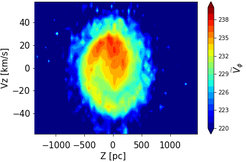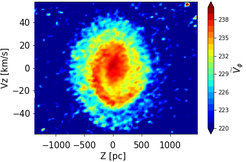Echo of the bar buckling: Phase space spirals in Gaia DR2 and N-body simulations
Khoperskov, S., Di Matteo, P., Gerhard, O., Katz, D., Haywood, M., Combes, F., et al., 2019, A&A, 622, L6


Since the publication of its second catalog, ESA's Gaia mission has been making new discoveries about the movement of stars in our Galaxy and its dynamic state. One of the most striking discoveries concerns the existence of spiral structures in z-Vz phase space. This has so far been interpreted as due to a state of non-equilibrium in our galaxy. Using an extremely high-resolution N-body simulation (N=141 million particles) we explore an alternative scenario of formation, evolution and spatial variation of the phase-space spirals similar to those recently discovered in Gaia DR2. For the first time in the literature, we use a self-consistent extremely high-resolution N-body simulation (N=141 million particles) of an isolated Milky Way-type galaxy to show that the phase-space spirals develop naturally from vertical oscillations driven by the buckling of the stellar bar (see Fig. 1). We claim that the physical mechanism standing behind the observed incomplete phase-space mixing process can be internal and not necessarily due to the perturbation induced by a massive satellite. In our model, the bending oscillations propagate outwards and produce axisymmetric variations of the mean vertical coordinate and of the vertical velocity component. As a consequence, the phase-space wrapping results in the formation of patterns with various morphology across the disk, depending on the bar orientation, distance to the galactic center and time elapsed since the bar buckling. Once bending waves appear, they are supported for a long time via disk self-gravity. In our isolated galaxy simulation, phase-space spirals are still distinguishable, at the solar neighbourhood, 3 Gyr after the buckling phase.
This work opens many questions and perspectives: is it possible to use these spirals to date the time of formation of the bar, which is still unknown in our Galaxy? And how to disentangle the signatures left by the formation of the bar from those due to the disturbance induced by massive satellites?

